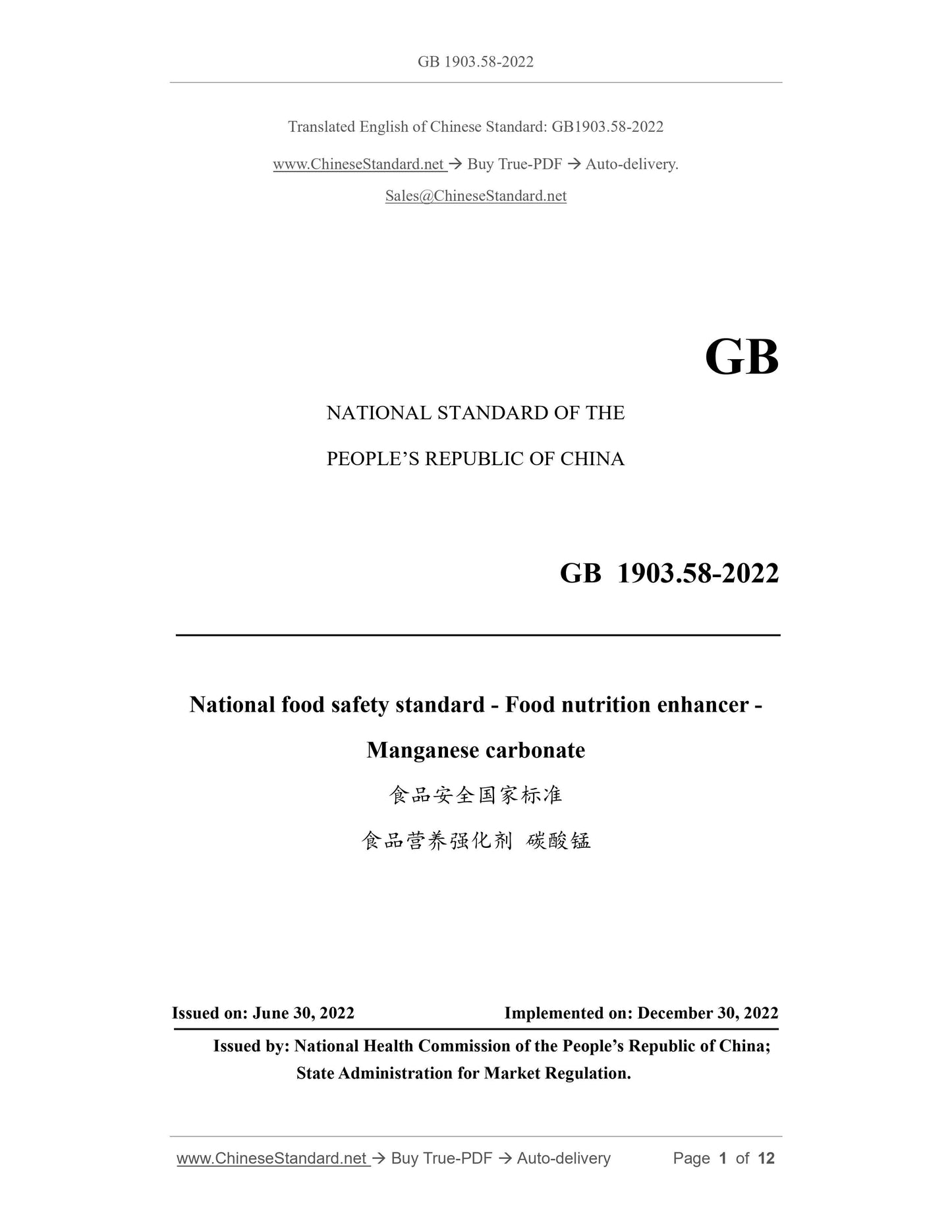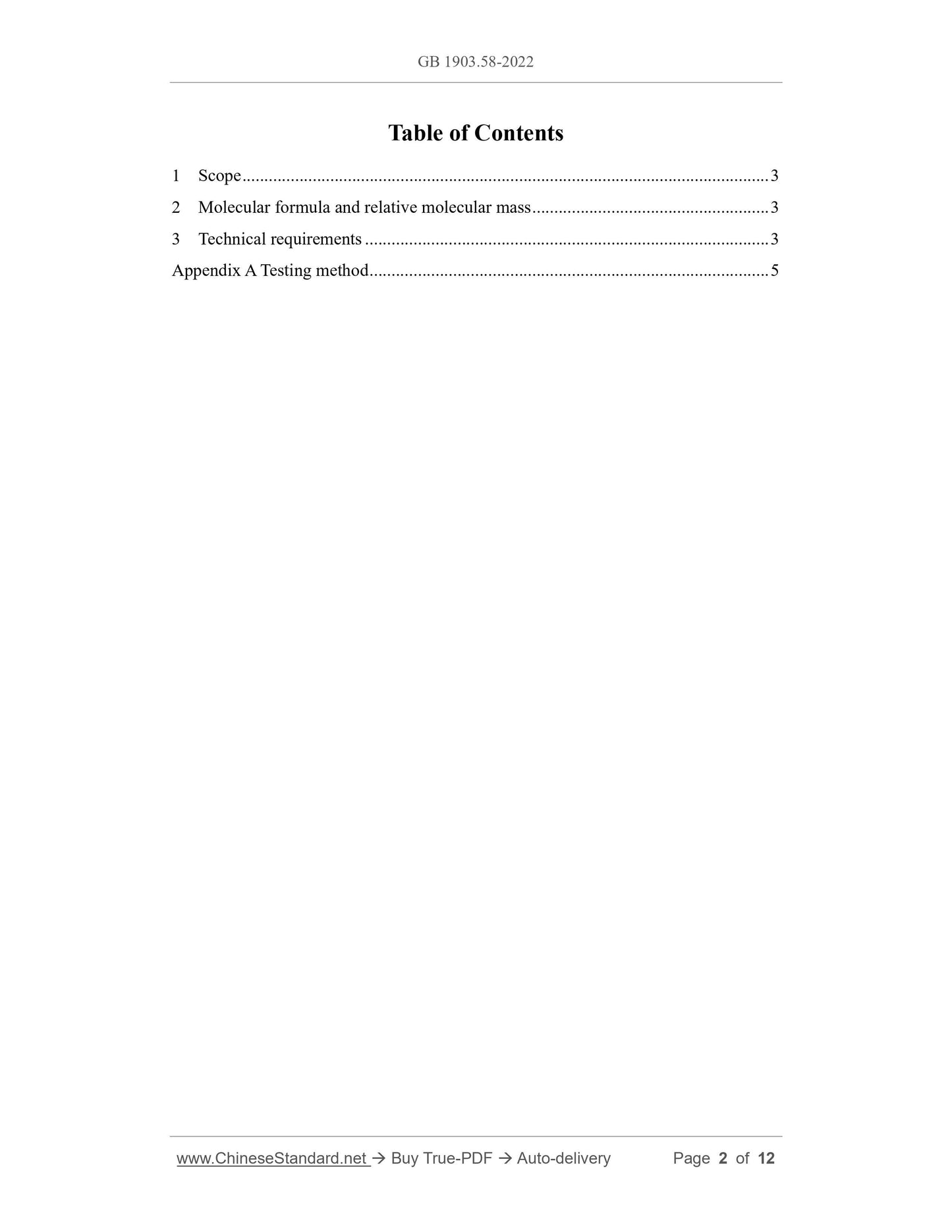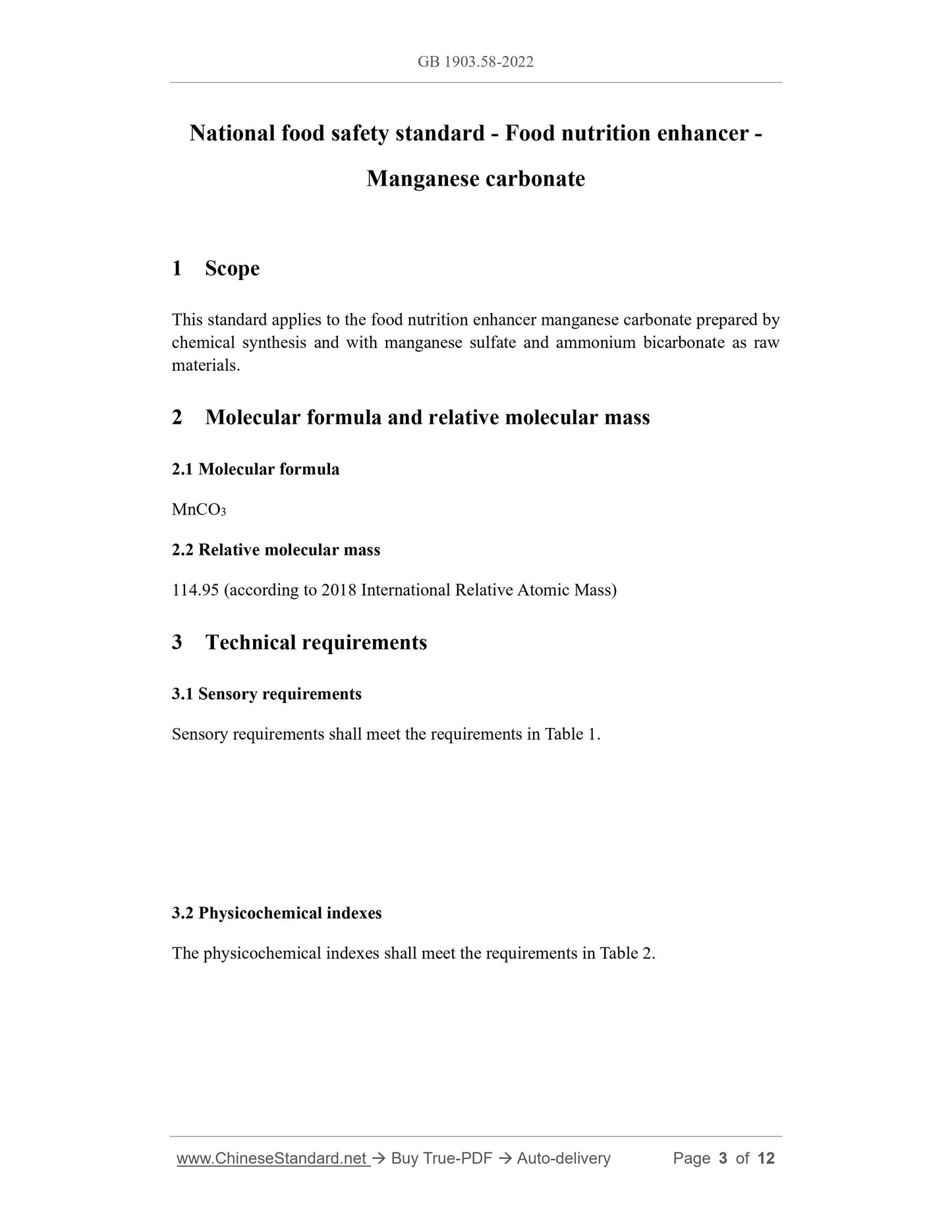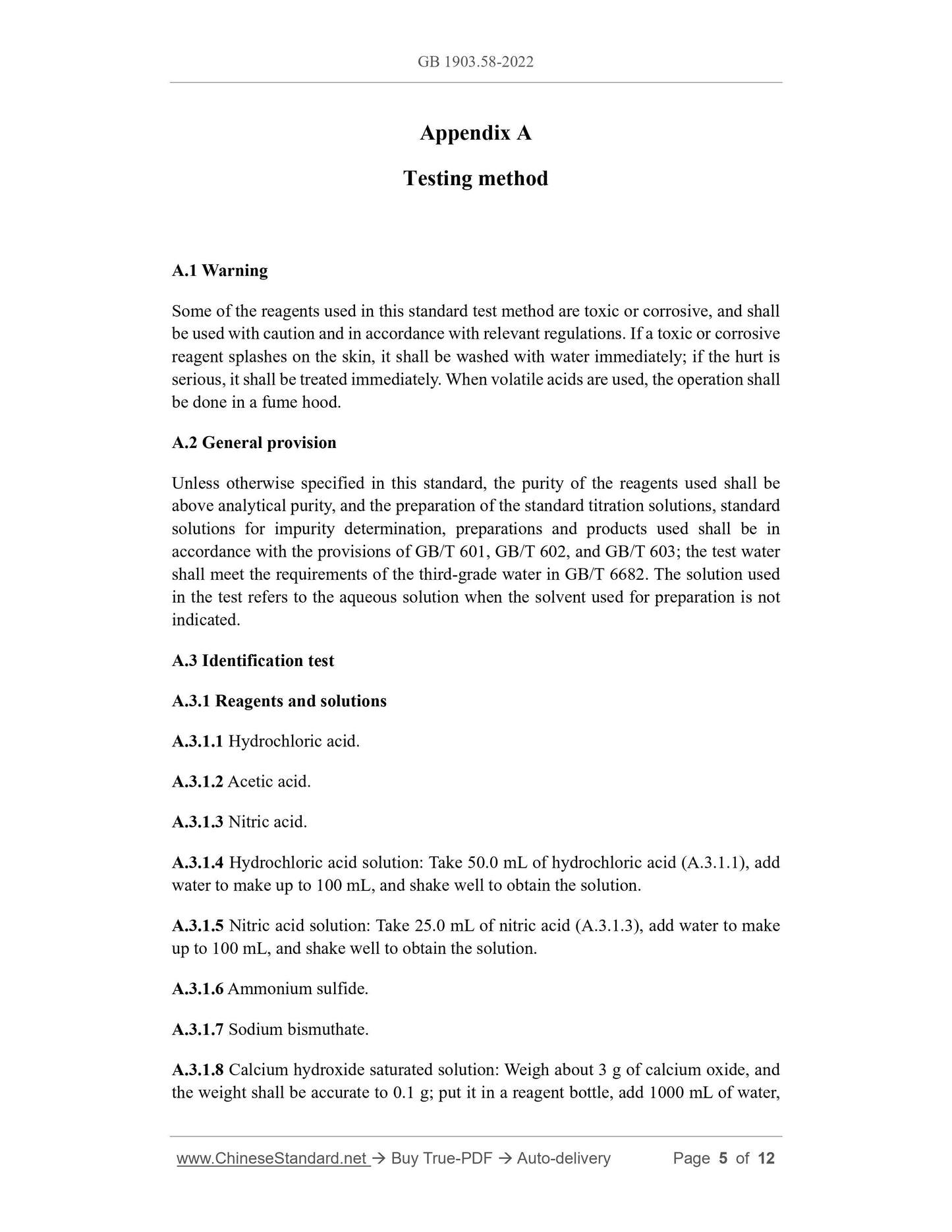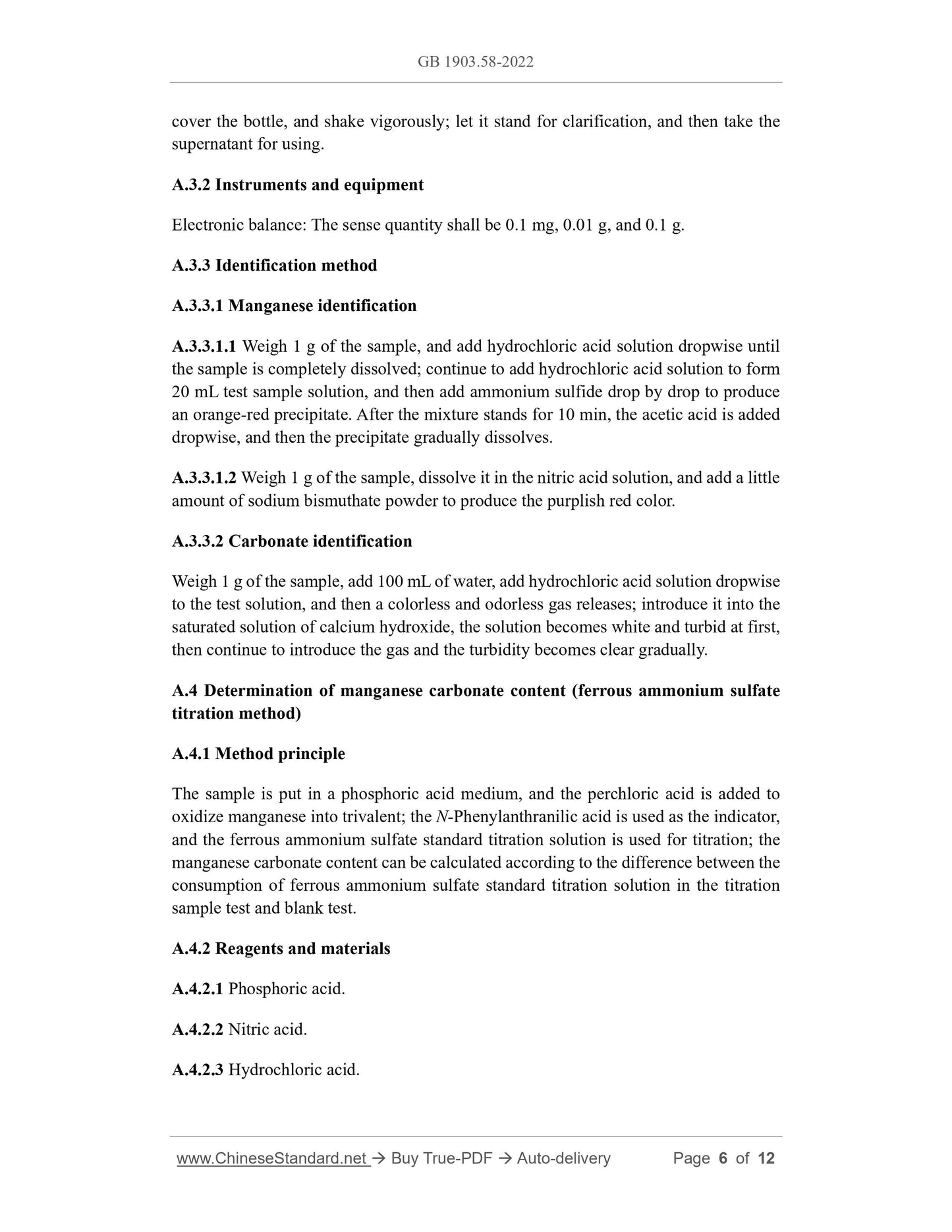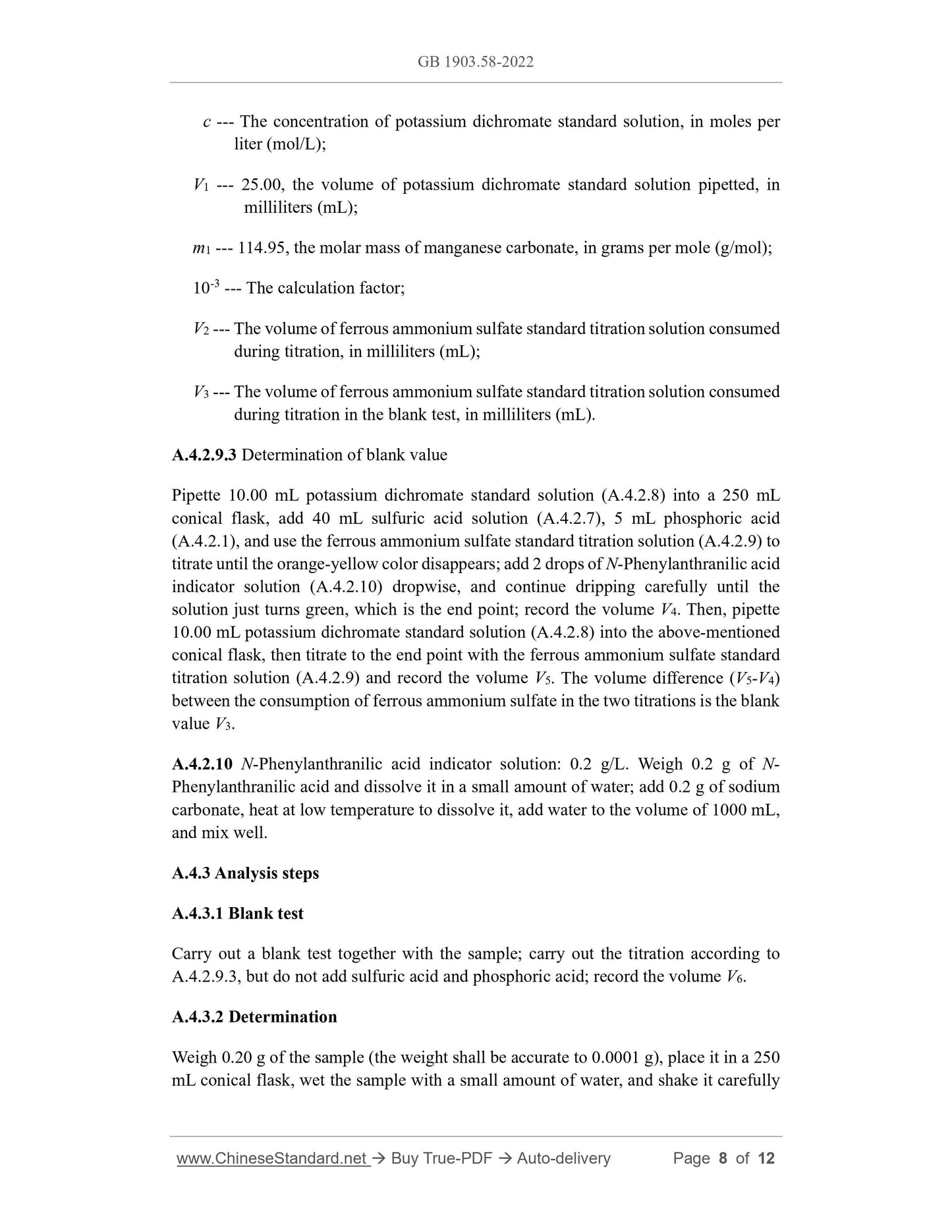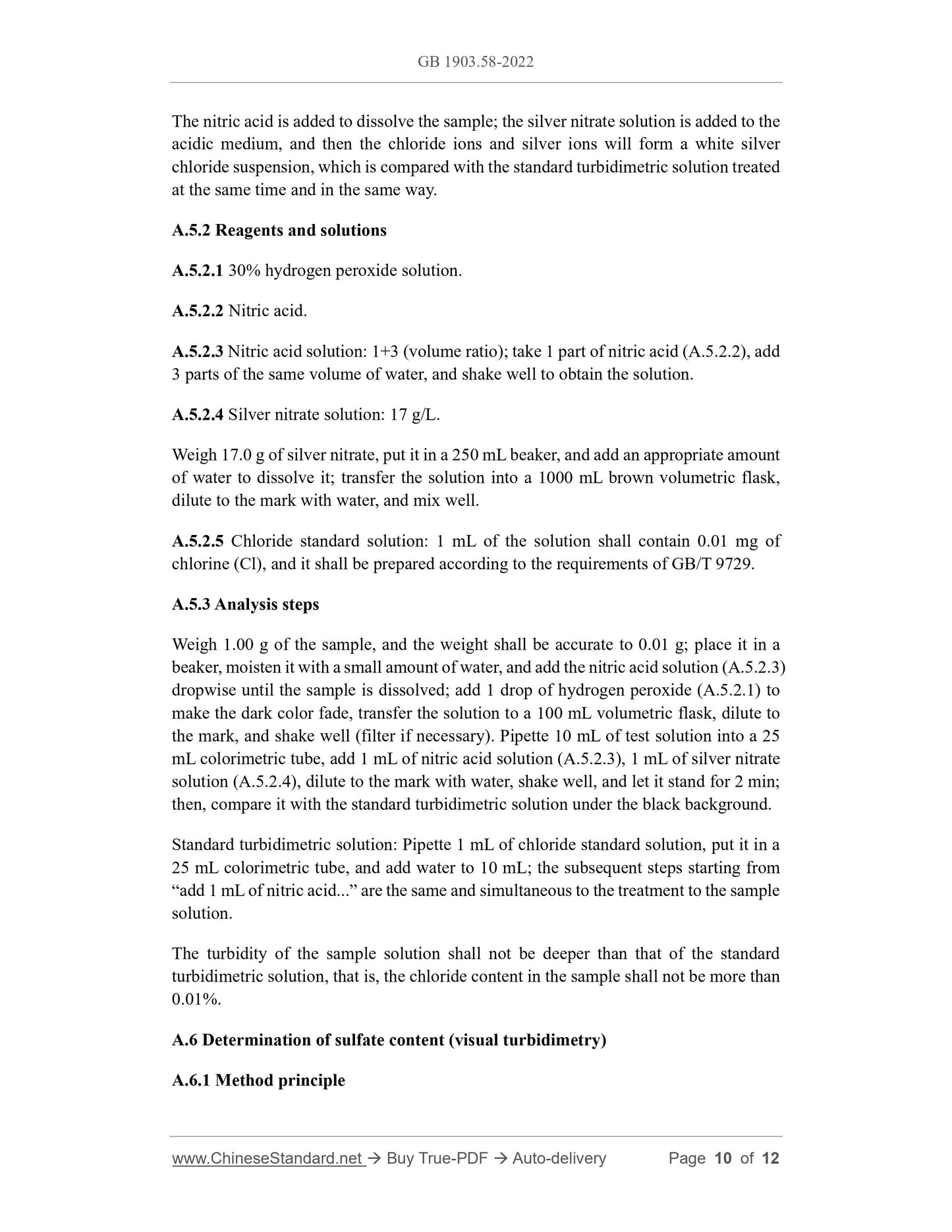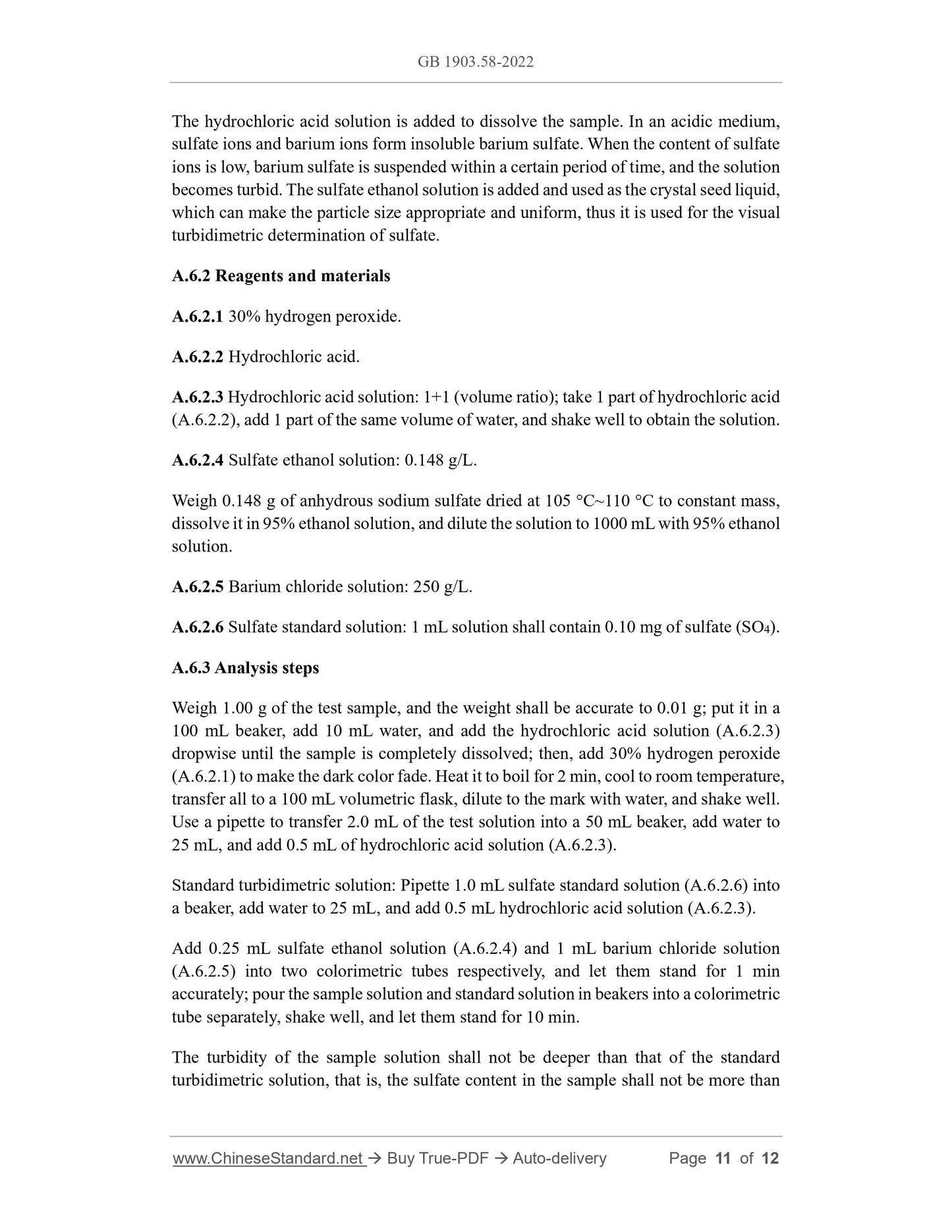1
/
of
8
www.ChineseStandard.us -- Field Test Asia Pte. Ltd.
GB 1903.58-2022 English PDF
GB 1903.58-2022 English PDF
Regular price
$95.00
Regular price
Sale price
$95.00
Unit price
/
per
Shipping calculated at checkout.
Couldn't load pickup availability
GB 1903.58-2022: National food safety standard - Food nutritional fortification substance - Manganous carbonate
Delivery: 9 seconds. Download (& Email) true-PDF + Invoice.
Get Quotation: Click GB 1903.58-2022 (Self-service in 1-minute)
Historical versions (Master-website): GB 1903.58-2022
Preview True-PDF (Reload/Scroll-down if blank)
GB 1903.58-2022
GB
NATIONAL STANDARD OF THE
PEOPLE’S REPUBLIC OF CHINA
National food safety standard - Food nutrition enhancer -
Manganese carbonate
食品营养强化剂 碳酸锰
ISSUED ON: JUNE 30, 2022
IMPLEMENTED ON: DECEMBER 30, 2022
Issued by: National Health Commission of the People’s Republic of China;
State Administration for Market Regulation.
Table of Contents
1 Scope ... 3
2 Molecular formula and relative molecular mass ... 3
3 Technical requirements ... 3
Appendix A Testing method ... 5
National food safety standard - Food nutrition enhancer -
Manganese carbonate
1 Scope
This standard applies to the food nutrition enhancer manganese carbonate prepared by
chemical synthesis and with manganese sulfate and ammonium bicarbonate as raw
materials.
2 Molecular formula and relative molecular mass
2.1 Molecular formula
MnCO3
2.2 Relative molecular mass
114.95 (according to 2018 International Relative Atomic Mass)
3 Technical requirements
3.1 Sensory requirements
Sensory requirements shall meet the requirements in Table 1.
3.2 Physicochemical indexes
The physicochemical indexes shall meet the requirements in Table 2.
Appendix A
Testing method
A.1 Warning
Some of the reagents used in this standard test method are toxic or corrosive, and shall
be used with caution and in accordance with relevant regulations. If a toxic or corrosive
reagent splashes on the skin, it shall be washed with water immediately; if the hurt is
serious, it shall be treated immediately. When volatile acids are used, the operation shall
be done in a fume hood.
A.2 General provision
Unless otherwise specified in this standard, the purity of the reagents used shall be
above analytical purity, and the preparation of the standard titration solutions, standard
solutions for impurity determination, preparations and products used shall be in
accordance with the provisions of GB/T 601, GB/T 602, and GB/T 603; the test water
shall meet the requirements of the third-grade water in GB/T 6682. The solution used
in the test refers to the aqueous solution when the solvent used for preparation is not
indicated.
A.3 Identification test
A.3.1 Reagents and solutions
A.3.1.1 Hydrochloric acid.
A.3.1.2 Acetic acid.
A.3.1.3 Nitric acid.
A.3.1.4 Hydrochloric acid solution: Take 50.0 mL of hydrochloric acid (A.3.1.1), add
water to make up to 100 mL, and shake well to obtain the solution.
A.3.1.5 Nitric acid solution: Take 25.0 mL of nitric acid (A.3.1.3), add water to make
up to 100 mL, and shake well to obtain the solution.
A.3.1.6 Ammonium sulfide.
A.3.1.7 Sodium bismuthate.
A.3.1.8 Calcium hydroxide saturated solution: Weigh about 3 g of calcium oxide, and
the weight shall be accurate to 0.1 g; put it in a reagent bottle, add 1000 mL of water,
cover the bottle, and shake vigorously; let it stand for clarification, and then take the
supernatant for using.
A.3.2 Instruments and equipment
Electronic balance: The sense quantity shall be 0.1 mg, 0.01 g, and 0.1 g.
A.3.3 Identification method
A.3.3.1 Manganese identification
A.3.3.1.1 Weigh 1 g of the sample, and add hydrochloric acid solution dropwise until
the sample is completely dissolved; continue to add hydrochloric acid solution to form
20 mL test sample solution, and then add ammonium sulfide drop by drop to produce
an orange-red precipitate. After the mixture stands for 10 min, the acetic acid is added
dropwise, and then the precipitate gradually dissolves.
A.3.3.1.2 Weigh 1 g of the sample, dissolve it in the nitric acid solution, and add a little
amount of sodium bismuthate powder to produce the purplish red color.
A.3.3.2 Carbonate identification
Weigh 1 g of the sample, add 100 mL of water, add hydrochloric acid solution dropwise
to the test solution, and then a colorless and odorless gas releases; introduce it into the
saturated solution of calcium hydroxide, the solution becomes white and turbid at first,
then continue to introduce the gas and the turbidity becomes clear gradually.
A.4 Determination of manganese carbonate content (ferrous ammonium sulfate
titration method)
A.4.1 Method principle
The sample is put in a phosphoric acid medium, and the perchloric acid is added to
oxidize manganese into trivalent; the N-Phenylanthranilic acid is used as the indicator,
and the ferrous ammonium sulfate standard titration solution is used for titration; the
manganese carbonate content can be calculated according to the difference between the
consumption of ferrous ammonium sulfate standard titration solution in the titration
sample test and blank test.
A.4.2 Reagents and materials
A.4.2.1 Phosphoric acid.
A.4.2.2 Nitric acid.
A.4.2.3 Hydrochloric acid.
c --- The concentration of potassium dichromate standard solution, in moles per
liter (mol/L);
V1 --- 25.00, the volume of potassium dichromate standard solution pipetted, in
milliliters (mL);
m1 --- 114.95, the molar mass of manganese carbonate, in grams per mole (g/mol);
10-3 --- The calculation factor;
V2 --- The volume of ferrous ammonium sulfate standard titration solution consumed
during titration, in milliliters (mL);
V3 --- The volume of ferrous ammonium sulfate standard titration solution consumed
during titration in the blank test, in milliliters (mL).
A.4.2.9.3 Determination of blank value
Pipette 10.00 mL potassium dichromate standard solution (A.4.2.8) into a 250 mL
conical flask, add 40 mL sulfuric acid solution (A.4.2.7), 5 mL phosphoric acid
(A.4.2.1), and use the ferrous ammonium sulfate standard titration solution (A.4.2.9) to
titrate until the orange-yellow color disappears; add 2 drops of N-Phenylanthranilic acid
indicator solution (A.4.2.10) dropwise, and continue dripping carefully until the
solution just turns green, which is the end point; record the volume V4. Then, pipette
10.00 mL potassium dichromate standard solution (A.4.2.8) into the above-mentioned
conical flask, then titrate to the end point with the ferrous ammonium sulfate standard
titration solution (A.4.2.9) and record the volume V5. The volume difference (V5-V4)
between the consumption of ferrous ammonium sulfate in the two titrations is the blank
value V3.
A.4.2.10 N-Phenylanthranilic acid indicator solution: 0.2 g/L. Weigh 0.2 g of N-
Phenylanthranilic acid and dissolve it in a small amount of water; add 0.2 g of sodium
carbonate, heat at low temperature to dissolve it, add water to the volume of 1000 mL,
and mix well.
A.4.3 Analysis steps
A.4.3.1 Blank test
Carry out a blank test together with the sample; carry out the titration according to
A.4.2.9.3, but do not add sulfuric acid and phosphoric acid; record the volume V6.
A.4.3.2 Determination
Weigh 0.20 g of the sample (the weight shall be accurate to 0.0001 g), place it in a 250
mL conical flask, wet the sample with a small amount of water, and shake it carefully
The nitric acid is added to dissolve the sample; the silver nitrate solution is added to the
acidic medium, and then the chloride ions and silver ions will form a white silver
chloride suspension, which is compared with the standard turbidimetric solution treated
at the same time and in the same way.
A.5.2 Reagents and solutions
A.5.2.1 30% hydrogen peroxide solution.
A.5.2.2 Nitric acid.
A.5.2.3 Nitric acid solution: 1+3 (volume ratio); take 1 part of nitric acid (A.5.2.2), add
3 parts of the same volume of water, and shake well to obtain the solution.
A.5.2.4 Silver nitrate solution: 17 g/L.
Weigh 17.0 g of silver nitrate, put it in a 250 mL beaker, and add an appropriate amount
of water to dissolve it; transfer the solution into a 1000 mL brown volumetric flask,
dilute to the mark with water, and mix well.
A.5.2.5 Chloride standard solution: 1 mL of the solution shall contain 0.01 mg of
chlorine (Cl), and it shall be prepared according to the requirements of GB/T 9729.
A.5.3 Analysis steps
Weigh 1.00 g of the sample, and the weight shall be accurate to 0.01 g; place it in a
beaker, moisten it with a small amount of water, and add the nitric acid solution (A.5.2.3)
dropwise until the sample is dissolved; add 1 drop of hydrogen peroxide (A.5.2.1) to
make the dark color fade, transfer the solution to a 100 mL volumetric flask, dilute to
the mark, and shake well (filter if necessary). Pipette 10 mL of test solution into a 25
mL colorimetric tube, add 1 mL of nitric acid solution (A.5.2.3), 1 mL of silver nitrate
solution (A.5.2.4), dilute to the mark with water, shake well, and let it stand for 2 min;
then, compare it with the standard turbidimetric solution under the black background.
Standard turbidimetric solution: Pipette 1 mL of chloride standard solution, put it in a
25 mL colorimetric tube, and add water to 10 mL; the subsequent steps starting from
“add 1 mL of nitric acid...” are the same and simultaneous to the treatment to the sample
solution.
The turbidity of the sample solution shall not be deeper than that of the standard
turbidimetric solution, that is, the chloride content in the sample shall not be more than
0.01%.
A.6 Determination of sulfate content (visual turbidimetry)
A.6.1 Method principle
The hydrochloric acid solution is added to dissolve the sample. In an acidic medium,
sulfate ions and barium ions form insoluble barium sulfate. When the content of sulfate
ions is low, barium sulfate is suspended within a certain period of time, and the solution
becomes turbid. The sulfate ethanol solution is added and used as the crystal seed liquid,
which can make the particle size appropriate and uniform, thus it is used for the visual
turbidimetric determination of sulfate.
A.6.2 Reagents and materials
A.6.2.1 30% hydrogen peroxide.
A.6.2.2 Hydrochloric acid.
A.6.2.3 Hydrochloric acid solution: 1+1 (volume ratio); take 1 part of hydrochloric acid
(A.6.2.2), add 1 part of the same volume of water, and shake well to obtain the solution.
A.6.2.4 Sulfate ethanol solution: 0.148 g/L.
Weigh 0.148 g of anhydrous sodium sulfate dried at 105 °C~110 °C to constant mass,
dissolve it in 95% ethanol solution, and dilute the solution to 1000 mL with 95% ethanol
solution.
A.6.2.5 Barium chloride solution: 250 g/L.
A.6.2.6 Sulfate standard solution: 1 mL solution shall contain 0.10 mg of sulfate (SO4).
A.6.3 Analysis steps
Weigh 1.00 g of the test sample, and the weight shall be accurate to 0.01 g; put it in a
100 mL beaker, add 10 mL water, and add the hydrochloric acid solution (A.6.2.3)
dropwise until the sample is completely dissolved; then, add 30% hydrogen peroxide
(A.6.2.1) to make the dark color fade. Heat it to boil for 2 min, cool to room temperature,
transfer all to a 100 mL volumetric flask, dilute to the mark with water, and shake well.
Use a pipette to transfer 2.0 mL of the test solution into a 50 mL beaker, add water to
25 mL, and add 0.5 mL of hydrochloric acid solution (A.6.2.3).
Standard turbidimetric solution: Pipette 1.0 mL sulfate standard solution (A.6.2.6) into
a beaker, add water to 25 mL, and add 0.5 mL hydrochloric acid solution (A.6.2.3).
Add 0.25 mL sulfate ethanol solution (A.6.2.4) and 1 mL barium chloride solution
(A.6.2.5) into two colorimetric tubes respectively, and let them stand for 1 min
accurately; pour the sample solution and standard solution in beakers into a colorimetric
tube separately, shake well, and let them stand for 10 min.
The turbidity of the sample solution shall not be deeper than that of the standard
turbidimetric solution, that is, the sulfate content in the sample shall not be more than
GB 1903.58-2022
GB
NATIONAL STANDARD OF THE
PEOPLE’S REPUBLIC OF CHINA
National food safety standard - Food nutrition enhancer -
Manganese carbonate
食品营养强化剂 碳酸锰
ISSUED ON: JUNE 30, 2022
IMPLEMENTED ON: DECEMBER 30, 2022
Issued by: National Health Commission of the People’s Republic of China;
State Administration for Market Regulation.
Table of Contents
1 Scope ... 3
2 Molecular formula and relative molecular mass ... 3
3 Technical requirements ... 3
Appendix A Testing method ... 5
National food safety standard - Food nutrition enhancer -
Manganese carbonate
1 Scope
This standard applies to the food nutrition enhancer manganese carbonate prepared by
chemical synthesis and with manganese sulfate and ammonium bicarbonate as raw
materials.
2 Molecular formula and relative molecular mass
2.1 Molecular formula
MnCO3
2.2 Relative molecular mass
114.95 (according to 2018 International Relative Atomic Mass)
3 Technical requirements
3.1 Sensory requirements
Sensory requirements shall meet the requirements in Table 1.
3.2 Physicochemical indexes
The physicochemical indexes shall meet the requirements in Table 2.
Appendix A
Testing method
A.1 Warning
Some of the reagents used in this standard test method are toxic or corrosive, and shall
be used with caution and in accordance with relevant regulations. If a toxic or corrosive
reagent splashes on the skin, it shall be washed with water immediately; if the hurt is
serious, it shall be treated immediately. When volatile acids are used, the operation shall
be done in a fume hood.
A.2 General provision
Unless otherwise specified in this standard, the purity of the reagents used shall be
above analytical purity, and the preparation of the standard titration solutions, standard
solutions for impurity determination, preparations and products used shall be in
accordance with the provisions of GB/T 601, GB/T 602, and GB/T 603; the test water
shall meet the requirements of the third-grade water in GB/T 6682. The solution used
in the test refers to the aqueous solution when the solvent used for preparation is not
indicated.
A.3 Identification test
A.3.1 Reagents and solutions
A.3.1.1 Hydrochloric acid.
A.3.1.2 Acetic acid.
A.3.1.3 Nitric acid.
A.3.1.4 Hydrochloric acid solution: Take 50.0 mL of hydrochloric acid (A.3.1.1), add
water to make up to 100 mL, and shake well to obtain the solution.
A.3.1.5 Nitric ac...
Delivery: 9 seconds. Download (& Email) true-PDF + Invoice.
Get Quotation: Click GB 1903.58-2022 (Self-service in 1-minute)
Historical versions (Master-website): GB 1903.58-2022
Preview True-PDF (Reload/Scroll-down if blank)
GB 1903.58-2022
GB
NATIONAL STANDARD OF THE
PEOPLE’S REPUBLIC OF CHINA
National food safety standard - Food nutrition enhancer -
Manganese carbonate
食品营养强化剂 碳酸锰
ISSUED ON: JUNE 30, 2022
IMPLEMENTED ON: DECEMBER 30, 2022
Issued by: National Health Commission of the People’s Republic of China;
State Administration for Market Regulation.
Table of Contents
1 Scope ... 3
2 Molecular formula and relative molecular mass ... 3
3 Technical requirements ... 3
Appendix A Testing method ... 5
National food safety standard - Food nutrition enhancer -
Manganese carbonate
1 Scope
This standard applies to the food nutrition enhancer manganese carbonate prepared by
chemical synthesis and with manganese sulfate and ammonium bicarbonate as raw
materials.
2 Molecular formula and relative molecular mass
2.1 Molecular formula
MnCO3
2.2 Relative molecular mass
114.95 (according to 2018 International Relative Atomic Mass)
3 Technical requirements
3.1 Sensory requirements
Sensory requirements shall meet the requirements in Table 1.
3.2 Physicochemical indexes
The physicochemical indexes shall meet the requirements in Table 2.
Appendix A
Testing method
A.1 Warning
Some of the reagents used in this standard test method are toxic or corrosive, and shall
be used with caution and in accordance with relevant regulations. If a toxic or corrosive
reagent splashes on the skin, it shall be washed with water immediately; if the hurt is
serious, it shall be treated immediately. When volatile acids are used, the operation shall
be done in a fume hood.
A.2 General provision
Unless otherwise specified in this standard, the purity of the reagents used shall be
above analytical purity, and the preparation of the standard titration solutions, standard
solutions for impurity determination, preparations and products used shall be in
accordance with the provisions of GB/T 601, GB/T 602, and GB/T 603; the test water
shall meet the requirements of the third-grade water in GB/T 6682. The solution used
in the test refers to the aqueous solution when the solvent used for preparation is not
indicated.
A.3 Identification test
A.3.1 Reagents and solutions
A.3.1.1 Hydrochloric acid.
A.3.1.2 Acetic acid.
A.3.1.3 Nitric acid.
A.3.1.4 Hydrochloric acid solution: Take 50.0 mL of hydrochloric acid (A.3.1.1), add
water to make up to 100 mL, and shake well to obtain the solution.
A.3.1.5 Nitric acid solution: Take 25.0 mL of nitric acid (A.3.1.3), add water to make
up to 100 mL, and shake well to obtain the solution.
A.3.1.6 Ammonium sulfide.
A.3.1.7 Sodium bismuthate.
A.3.1.8 Calcium hydroxide saturated solution: Weigh about 3 g of calcium oxide, and
the weight shall be accurate to 0.1 g; put it in a reagent bottle, add 1000 mL of water,
cover the bottle, and shake vigorously; let it stand for clarification, and then take the
supernatant for using.
A.3.2 Instruments and equipment
Electronic balance: The sense quantity shall be 0.1 mg, 0.01 g, and 0.1 g.
A.3.3 Identification method
A.3.3.1 Manganese identification
A.3.3.1.1 Weigh 1 g of the sample, and add hydrochloric acid solution dropwise until
the sample is completely dissolved; continue to add hydrochloric acid solution to form
20 mL test sample solution, and then add ammonium sulfide drop by drop to produce
an orange-red precipitate. After the mixture stands for 10 min, the acetic acid is added
dropwise, and then the precipitate gradually dissolves.
A.3.3.1.2 Weigh 1 g of the sample, dissolve it in the nitric acid solution, and add a little
amount of sodium bismuthate powder to produce the purplish red color.
A.3.3.2 Carbonate identification
Weigh 1 g of the sample, add 100 mL of water, add hydrochloric acid solution dropwise
to the test solution, and then a colorless and odorless gas releases; introduce it into the
saturated solution of calcium hydroxide, the solution becomes white and turbid at first,
then continue to introduce the gas and the turbidity becomes clear gradually.
A.4 Determination of manganese carbonate content (ferrous ammonium sulfate
titration method)
A.4.1 Method principle
The sample is put in a phosphoric acid medium, and the perchloric acid is added to
oxidize manganese into trivalent; the N-Phenylanthranilic acid is used as the indicator,
and the ferrous ammonium sulfate standard titration solution is used for titration; the
manganese carbonate content can be calculated according to the difference between the
consumption of ferrous ammonium sulfate standard titration solution in the titration
sample test and blank test.
A.4.2 Reagents and materials
A.4.2.1 Phosphoric acid.
A.4.2.2 Nitric acid.
A.4.2.3 Hydrochloric acid.
c --- The concentration of potassium dichromate standard solution, in moles per
liter (mol/L);
V1 --- 25.00, the volume of potassium dichromate standard solution pipetted, in
milliliters (mL);
m1 --- 114.95, the molar mass of manganese carbonate, in grams per mole (g/mol);
10-3 --- The calculation factor;
V2 --- The volume of ferrous ammonium sulfate standard titration solution consumed
during titration, in milliliters (mL);
V3 --- The volume of ferrous ammonium sulfate standard titration solution consumed
during titration in the blank test, in milliliters (mL).
A.4.2.9.3 Determination of blank value
Pipette 10.00 mL potassium dichromate standard solution (A.4.2.8) into a 250 mL
conical flask, add 40 mL sulfuric acid solution (A.4.2.7), 5 mL phosphoric acid
(A.4.2.1), and use the ferrous ammonium sulfate standard titration solution (A.4.2.9) to
titrate until the orange-yellow color disappears; add 2 drops of N-Phenylanthranilic acid
indicator solution (A.4.2.10) dropwise, and continue dripping carefully until the
solution just turns green, which is the end point; record the volume V4. Then, pipette
10.00 mL potassium dichromate standard solution (A.4.2.8) into the above-mentioned
conical flask, then titrate to the end point with the ferrous ammonium sulfate standard
titration solution (A.4.2.9) and record the volume V5. The volume difference (V5-V4)
between the consumption of ferrous ammonium sulfate in the two titrations is the blank
value V3.
A.4.2.10 N-Phenylanthranilic acid indicator solution: 0.2 g/L. Weigh 0.2 g of N-
Phenylanthranilic acid and dissolve it in a small amount of water; add 0.2 g of sodium
carbonate, heat at low temperature to dissolve it, add water to the volume of 1000 mL,
and mix well.
A.4.3 Analysis steps
A.4.3.1 Blank test
Carry out a blank test together with the sample; carry out the titration according to
A.4.2.9.3, but do not add sulfuric acid and phosphoric acid; record the volume V6.
A.4.3.2 Determination
Weigh 0.20 g of the sample (the weight shall be accurate to 0.0001 g), place it in a 250
mL conical flask, wet the sample with a small amount of water, and shake it carefully
The nitric acid is added to dissolve the sample; the silver nitrate solution is added to the
acidic medium, and then the chloride ions and silver ions will form a white silver
chloride suspension, which is compared with the standard turbidimetric solution treated
at the same time and in the same way.
A.5.2 Reagents and solutions
A.5.2.1 30% hydrogen peroxide solution.
A.5.2.2 Nitric acid.
A.5.2.3 Nitric acid solution: 1+3 (volume ratio); take 1 part of nitric acid (A.5.2.2), add
3 parts of the same volume of water, and shake well to obtain the solution.
A.5.2.4 Silver nitrate solution: 17 g/L.
Weigh 17.0 g of silver nitrate, put it in a 250 mL beaker, and add an appropriate amount
of water to dissolve it; transfer the solution into a 1000 mL brown volumetric flask,
dilute to the mark with water, and mix well.
A.5.2.5 Chloride standard solution: 1 mL of the solution shall contain 0.01 mg of
chlorine (Cl), and it shall be prepared according to the requirements of GB/T 9729.
A.5.3 Analysis steps
Weigh 1.00 g of the sample, and the weight shall be accurate to 0.01 g; place it in a
beaker, moisten it with a small amount of water, and add the nitric acid solution (A.5.2.3)
dropwise until the sample is dissolved; add 1 drop of hydrogen peroxide (A.5.2.1) to
make the dark color fade, transfer the solution to a 100 mL volumetric flask, dilute to
the mark, and shake well (filter if necessary). Pipette 10 mL of test solution into a 25
mL colorimetric tube, add 1 mL of nitric acid solution (A.5.2.3), 1 mL of silver nitrate
solution (A.5.2.4), dilute to the mark with water, shake well, and let it stand for 2 min;
then, compare it with the standard turbidimetric solution under the black background.
Standard turbidimetric solution: Pipette 1 mL of chloride standard solution, put it in a
25 mL colorimetric tube, and add water to 10 mL; the subsequent steps starting from
“add 1 mL of nitric acid...” are the same and simultaneous to the treatment to the sample
solution.
The turbidity of the sample solution shall not be deeper than that of the standard
turbidimetric solution, that is, the chloride content in the sample shall not be more than
0.01%.
A.6 Determination of sulfate content (visual turbidimetry)
A.6.1 Method principle
The hydrochloric acid solution is added to dissolve the sample. In an acidic medium,
sulfate ions and barium ions form insoluble barium sulfate. When the content of sulfate
ions is low, barium sulfate is suspended within a certain period of time, and the solution
becomes turbid. The sulfate ethanol solution is added and used as the crystal seed liquid,
which can make the particle size appropriate and uniform, thus it is used for the visual
turbidimetric determination of sulfate.
A.6.2 Reagents and materials
A.6.2.1 30% hydrogen peroxide.
A.6.2.2 Hydrochloric acid.
A.6.2.3 Hydrochloric acid solution: 1+1 (volume ratio); take 1 part of hydrochloric acid
(A.6.2.2), add 1 part of the same volume of water, and shake well to obtain the solution.
A.6.2.4 Sulfate ethanol solution: 0.148 g/L.
Weigh 0.148 g of anhydrous sodium sulfate dried at 105 °C~110 °C to constant mass,
dissolve it in 95% ethanol solution, and dilute the solution to 1000 mL with 95% ethanol
solution.
A.6.2.5 Barium chloride solution: 250 g/L.
A.6.2.6 Sulfate standard solution: 1 mL solution shall contain 0.10 mg of sulfate (SO4).
A.6.3 Analysis steps
Weigh 1.00 g of the test sample, and the weight shall be accurate to 0.01 g; put it in a
100 mL beaker, add 10 mL water, and add the hydrochloric acid solution (A.6.2.3)
dropwise until the sample is completely dissolved; then, add 30% hydrogen peroxide
(A.6.2.1) to make the dark color fade. Heat it to boil for 2 min, cool to room temperature,
transfer all to a 100 mL volumetric flask, dilute to the mark with water, and shake well.
Use a pipette to transfer 2.0 mL of the test solution into a 50 mL beaker, add water to
25 mL, and add 0.5 mL of hydrochloric acid solution (A.6.2.3).
Standard turbidimetric solution: Pipette 1.0 mL sulfate standard solution (A.6.2.6) into
a beaker, add water to 25 mL, and add 0.5 mL hydrochloric acid solution (A.6.2.3).
Add 0.25 mL sulfate ethanol solution (A.6.2.4) and 1 mL barium chloride solution
(A.6.2.5) into two colorimetric tubes respectively, and let them stand for 1 min
accurately; pour the sample solution and standard solution in beakers into a colorimetric
tube separately, shake well, and let them stand for 10 min.
The turbidity of the sample solution shall not be deeper than that of the standard
turbidimetric solution, that is, the sulfate content in the sample shall not be more than
GB 1903.58-2022
GB
NATIONAL STANDARD OF THE
PEOPLE’S REPUBLIC OF CHINA
National food safety standard - Food nutrition enhancer -
Manganese carbonate
食品营养强化剂 碳酸锰
ISSUED ON: JUNE 30, 2022
IMPLEMENTED ON: DECEMBER 30, 2022
Issued by: National Health Commission of the People’s Republic of China;
State Administration for Market Regulation.
Table of Contents
1 Scope ... 3
2 Molecular formula and relative molecular mass ... 3
3 Technical requirements ... 3
Appendix A Testing method ... 5
National food safety standard - Food nutrition enhancer -
Manganese carbonate
1 Scope
This standard applies to the food nutrition enhancer manganese carbonate prepared by
chemical synthesis and with manganese sulfate and ammonium bicarbonate as raw
materials.
2 Molecular formula and relative molecular mass
2.1 Molecular formula
MnCO3
2.2 Relative molecular mass
114.95 (according to 2018 International Relative Atomic Mass)
3 Technical requirements
3.1 Sensory requirements
Sensory requirements shall meet the requirements in Table 1.
3.2 Physicochemical indexes
The physicochemical indexes shall meet the requirements in Table 2.
Appendix A
Testing method
A.1 Warning
Some of the reagents used in this standard test method are toxic or corrosive, and shall
be used with caution and in accordance with relevant regulations. If a toxic or corrosive
reagent splashes on the skin, it shall be washed with water immediately; if the hurt is
serious, it shall be treated immediately. When volatile acids are used, the operation shall
be done in a fume hood.
A.2 General provision
Unless otherwise specified in this standard, the purity of the reagents used shall be
above analytical purity, and the preparation of the standard titration solutions, standard
solutions for impurity determination, preparations and products used shall be in
accordance with the provisions of GB/T 601, GB/T 602, and GB/T 603; the test water
shall meet the requirements of the third-grade water in GB/T 6682. The solution used
in the test refers to the aqueous solution when the solvent used for preparation is not
indicated.
A.3 Identification test
A.3.1 Reagents and solutions
A.3.1.1 Hydrochloric acid.
A.3.1.2 Acetic acid.
A.3.1.3 Nitric acid.
A.3.1.4 Hydrochloric acid solution: Take 50.0 mL of hydrochloric acid (A.3.1.1), add
water to make up to 100 mL, and shake well to obtain the solution.
A.3.1.5 Nitric ac...
Share
